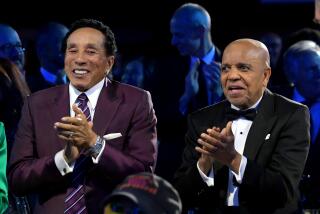POP MUSIC REVIEWS : Mighty Clouds Sing Rock ( ‘n’ Roll) of Ages
- Share via
COSTA MESA — Everyone knows that gospel music has had a heavy impact on popular music, particularly on the Motown sound and oth& B forms as well as the whole of rock ‘n’ roll. But just in case that fact had been forgotten, the Mighty Clouds of Joy reinforced the lesson when they blew into Orange Coast College’s Robert B. Moore Theatre on Friday.
The gospel-rock connection is a two-way street with the Mighty Clouds. Not only did the eight-piece group perform heaven-bent, soul-stirring spirituals and songs of devotion of the kind that has defined their work for more than 35 years, they also included just enough numbers from the pop charts to provide an object lesson in the history of rock ‘n’ roll.
One couldn’t help hear the connection between the genres in the Clouds’ opening two numbers. They came on stage to an upbeat, hand-clapping rendition of “Move On Up a Little Higher,” written after the turn of the century by one of gospel’s innovators, Herbert Brewster Sr. They followed it with a slow, stately version of “Love Train,” the dance hit the O’Jays took to No. 1 on the R & B charts in 1973. Both the message of as aspiration and the underlying feel of the two selections, though done at different tempos, were strikingly consistent.
*
The group also performed “You Are So Beautiful,” the Joe Cocker hit, in soulful ballad style as well as Bette Midler’s big seller “The Wind Beneath My Wings.” It didn’t take much imagination to see how each of these pop numbers fit into a program of gospel music as each has a devotional message that can be interpreted on both worldly and spiritual levels.
And just in case these examples didn’t drive the point home, the group made humorous visual connections as lead vocalist Joe Ligon slid James Brown style across the stage and guitarist-musical director Dwight Gordon borrowed a page from Little Richard as he did the duck-strut in front of the band.
Still, this was no rock concert.
In fact, the theater often took on the airs of a revivalist’s tent as the Clouds brought members of the audience to their feet to clap, wave and testify with the band. Elmer Gantry couldn’t have done it better.
Most of the electricity was generated by Ligon, whose soaring, somewhat gruff tones, sprinkled with shouts, searing cries and deep-throated, wordless interludes, filled the hall on nearly every tune. By now, it’s not news that Ligon, who’s been credited with influencing everyone from Levi Stubbs of the Four Tops to the Godfather of Soul himself (Brown), has one of the most expansive vocal instruments around. What is amazing is that he is able to maintain such a strong, all-out sound for the duration of an evening.
Ligon gets good support from “high” tenor Wilbert Williams, who hit an incredible whistling falsetto note during “Love Train” and tenor Michael McCowan, whose voice stands in pure contrast to Ligon’s more gravelly sounds. Harmonies, whether three- or four-part, were seamless throughout the evening, as baritone Richard Wallace added solid bottom-end vocals (he also doubled on bass guitar) and Gordon added his voice on select songs.
Though the accompaniment was less polished than the vocals--drummer Johnny Valentine occasionally wandered astray over bridges--the instrumental side of the clouds fits neatly into their formula, with organist Hampton Carlton adding sanctified touches and keyboardist Alphonso McClain working up blues and orchestral effects from his synthesizers. And when the band was called on to rock, it delivered.
But the group was most impressive during quiet numbers. Their a capella feature, “Working on the Building,” sung quietly and just back from the microphones in four-part harmony, was the sweetest moment of the evening.
More to Read
The biggest entertainment stories
Get our big stories about Hollywood, film, television, music, arts, culture and more right in your inbox as soon as they publish.
You may occasionally receive promotional content from the Los Angeles Times.








